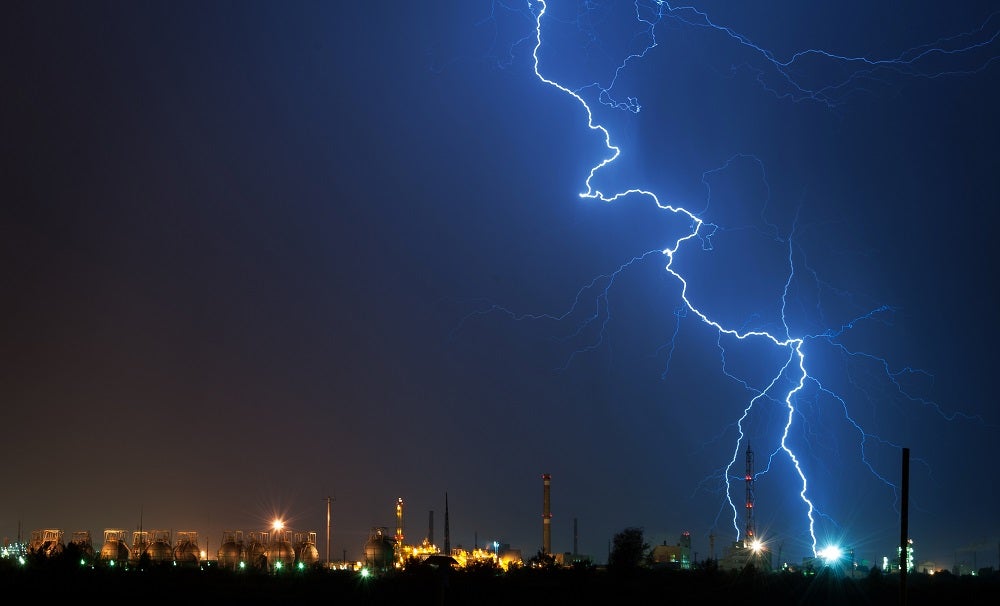
Protecting facilities from the effects of lightning and induced-surge transients is an essential part of keeping workers safe and protecting the integrity of electrical equipment. There is no all-encompassing piece of equipment that can stop lightning in its tracks, but the electric safety experts at nVent ERICO have composed a six-point protection approach that provides a comprehensive checklist covering all damage mechanisms.
Damage caused by direct lightning strikes or surges conducted via power and telecommunication lines cost large facilities billions of dollars every year, and this is before considering the loss of productivity due to downtime. Preventing damage involves effectively capturing, conducting, and dissipating this energy to ground, as well as clamping and diverting transients arriving at the site through external cables.
So, how does nVent’s safety solution work? The protection plan is split into six points:
-
Capturing direct lightning strikes using air terminals
Often the most vulnerable point to a direct strike is the highest peak. By correctly installing a purpose-designed air terminal, direct lightning strikes can be captured at a preferred point that is situated away from antennae and cabling.
nVent ERICO’s Dynasphere is an enhanced version of an air terminal in the sense that it controls the initiation of a leader and reliably captures lightning. But it is not an Early Streamer Emission (ESE) terminal. Operations differ in that the Dynasphere relies on capacitive coupling to the downleader, and only launches a leader when the electric field is high enough to sustain leader propagation. This is because early initiation has no benefit and can in fact delay further leader initiation attempts due to residual charge.
-
Conduct current to ground safely via downconductor system
Step two minimises the dangers of side-flashing. Once the lightning has been captured it needs to be discharged safely to ground. The function of a downconductor system is to provide a low impedance path to the ground system without developing excessively large voltages.
nVent ERICO has developed a purpose-designed, screened, insulated downconductor cable. It is designed to reduce the risk of side flashing and contains the discharge within the central core conductor during a strike.
-
Dissipate energy into the ground with minimal rise in ground potential
Now that the energy has been conducted to ground level via the downconductor cable, a low impedance ground is required to effectively dissipate the lightning energy into the earth. The grounding systems for dedicated lightning protection terminals, tower footings and electronic equipment rooms or control centres are critical design elements.
nVent ERICO offers grounding and bonding solutions from grounding rods to Ground Enhancement Material (GEM) and mats/meshes.
-
Eliminate earth loops and differentials by creating an equipotential grounding plane
All grounding systems must be of high integrity and be considered a component of an overall grounding network. Separate grounds need to be bonded together, especially under transient conditions to limit earth loops and excessive voltage build up that can damage equipment and present a safety risk to personnel.
-
Protect equipment from surges and transients on power lines
There are two considerations when determining the surge rating of a Surge Protection Device (SPD) for a specific location. Firstly, what is the largest surge impulse the site is likely to experience, and will the rating provide sufficient operational life under the more frequent smaller impulses.
A SPD is intended to limit the transient voltage or prevent it from reaching the equipment. No SPD device is infallible, but letting some voltage through is only acceptable within the ranges that protected equipment can withstand, and over time it can still cause stress to equipment.
-
Protect communications and signal lines
While protecting data and communications equipment involves many of the same factors including in point five, the differing exposure levels, lower operating voltages and increased sensitivity of equipment mean that the parameters of each surge protector need to be carefully selected.
To ensure cost-effective protection for data, signalling and control circuits, two issues need to be addressed; where the SPD should be installed, and what type of SPD is appropriate for each circuit type and location.
nVent combines global resources, localised expertise, and customer support to work with large facilities to help them choose the right products and build effective lightning protection systems. For more information about nVent’s portfolio of brands, or to find out how their solutions can support your mining or industrial project, visit their website.


